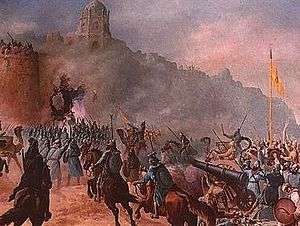Afghan–Sikh Wars
| Afghan-Sikh Wars | |||||||
|---|---|---|---|---|---|---|---|
 Top: Battle of Multan | |||||||
| |||||||
| Belligerents | |||||||
|
* |
* | ||||||
| Commanders and leaders | |||||||
|
|
| ||||||
| Strength | |||||||
|
During Ahmad Shah Durrani's invasions:Estimated 100,000 each time During invasions of Zaman Shah Durrani: Estimated 60,000 During Maharaja Ranjit Singh's counterattack: Estimated 180,000 (including tribes) |
During Ahmad Shah Durrani's early invasions: 50,000 Khalsa During late Ahmad Shah Abdali invasions: Estimated 60,000 Misldar Army:Estimated 100,000 Sikh Empire period: 120,000. | ||||||
| Casualties and losses | |||||||
|
First Phase: Estimated 24,000 Second Phase: Estimated 20,000 Third Phase: Estimated 26,000 |
First Phase: Estimated 38,000 Second Phase: Estimated 60,000 Third Phase: Estimated 32,000 | ||||||
The Afghan–Sikh wars were a series of wars between the Afghan Pashtuns Durrani Empire, and the Sikh Empire. The conflict had its origins stemming from the days of the Dal Khalsa.
Battle of Attock
This war started with the Battle of Attock, also known as the Battle of Chuch or the Battle of Haidru, this was the first significant Pashtun victory over the Sikh Empire. In the aftermath of this battle, Pashtuns had seized the control of Attock District. After his victory at Attock, Zaman Khan, the vizier of Kabul, fought off an attempt by Ali Shah, the ruler of Persia, and his son Ali Mirza to capture the Durrani province of Herat, which left their newly captured province of Kashmir open to attack.[1]
Battle of Multan
The Battle of Multan was the 2nd battle in the Afghan–Sikh wars, which the Sikhs had also won. This started in March 1818 and ended 2 June 1818.[2] This battle ended the Durrani influence in the Khyber Pakhtunkhwa region, and led to Sikhs holding the city of Peshawar.
Battle of Shopian
The Battle of Shopian was different from the first two battles, due to it taking place in the Kashmir region, more specifically Shopian. This was the 3rd battle in the Afghan–Sikh wars and the 3rd Sikh victory. This battle included the 1819 Kashmir expedition, which led to Kashmir being annexed to the Sikh Empire.[3] After taking Srinagar, the Sikh army faced no major opposition in conquering Kashmir. The Sikh Empire had controlled all of Kashmir.[4]
Battle of Nowshera
The Battle of Nowshera wasn't fought by the Durranis, but by a Pashtun force with support of the Durranis. This was the 4th battle in the Afghan–Sikh wars and 4th Sikh victory.[5] After this, the Sikhs again came in possession of Peshawar, along with the whole Khyber Pass. With this victory, Maharaja Ranjit Singh planned to eventually push further west and take the Afghan capital of Kabul itself.
Battle of Jamrud
The Battle of Jamrud was the 5th and foremost battle within the Afghan–Sikh wars. The Afghans had been losing their long held territories to Sikhs over the preceding years due to internal conflicts, and had seen their once mighty empire shrink with the loss of the Punjab region, Multan, Kashmir and Khyber Pakhtunkhwa. The loss of Peshawar was the most personal as the inhabitants of the region were fellow Pashtuns and the city was the second capital of Afghanistan, so the Afghans set to reclaim it.[6] As a result of this battle, Jamrud and the Khyber pass became the western limits of Sikh influence.
References
- ↑ Cunningham 1918, p. 152
- ↑ Jaques 2006, p. 81
- ↑ Chopra 1928, p. 26
- ↑ Chopra 1928, p. 26
- ↑ Ganda Singh (1986) Maharaja Ranjit Singh: First Death Centenary Memorial. Nirmal Publishers
- ↑ The Encyclopedia of Nineteenth-century Land Warfare: An Illustrated World View, by Byron Farwell Published by W.W. Norton, 2001. ISBN 0-393-04770-9, ISBN 978-0-393-04770-7.